June marks the 25th Anniversary of Gramercy! Thank you to our valued investors, trusted business partners and team members without whom this milestone could not have been reached. We are excited for the opportunities we see ahead, and look forward to continuing to deliver upon our mission to have a positive impact on the well-being of our clients, portfolio investments (and their communities) and our team members.
Contents
Market Overview
Macro Review
Talk hawkish, act dovish. Did the FOMC just skip or pause? The Bank of Canada paused in January, but continued the tightening cycle in June, so that ought to be in the back of investors’ minds. The June Summary of Economic Projections suggests two further 25bps hikes to arrive at a median dot of 5.625%, with a top dot projection of 6.125%. In turn, the market priced-out cuts in 2023. The degree of G10 curve inversion across 2s10s has become more extreme as financial conditions remain loose, which is in contrast to the quantitative tightening that central banks speak of. The Australian curve inverted for the first time on a 3s10s basis and is consistent with this theme, which was partly driven by New Zealand’s negative GDP print and confirmation of a technical recession. Equities continued to tick higher with the S&P at a 10-month high and strung together six consecutive daily gains, which hasn’t been seen since November 2021. Meanwhile, the Nasdaq is up north of 30% this year. Christine Lagarde, President of the European Central Bank, said there was a no trade-off between price and financial stability in the March ECB address and confirmed as much on Thursday. Empirically this has proven incorrect as cracks have emerged. Yet there is still scope for a non-recession recession as Apollo put it. After all, the Fed has hiked 500bps over 10 consecutive meetings and the employment market is still remarkably strong. The only alarm this week was from initial jobless claims which rose to its highest level since October 2021. Instead, the idea of immaculate disinflation has come under increased scrutiny. In this vein, equity volatility (VIX) as a ratio to U.S. Treasury volatility (MOVE) fell to lows not seen since 1996. The observation in China is more nuanced. Softening demand, weak export growth, fragile credit creation and volatile PMIs add a dose of realism to global economic distortions. The PBoC also cut the 7-day RRR by 10bps to 1.9% for the first time since August 2022 and the MLF rate was reduced by 10bps to 2.65%. These initiatives saw 2-year and 5-year swap spreads collapse and CNH move to 8-month highs. The story of last week was the weakness in the Turkish lira. The development this week was around the Nigerian naira devaluation given the changes in government and at the Central Bank. More broadly, the strength in EMFX over the week was notable (excluding the naira), although somewhat overshadowed by NOK, GBP and SEK appreciating more than 2% with a hawkish ECB that drove EUR higher.
EM Credit Update
Emerging market sovereign credit (cash bonds) ended the week up 0.6% with spreads 6bps tighter as U.S. Treasury yields were stable away from the 2-year and 3-year tenors. Sovereign outperformers were Zambia, Tunisia and Suriname, while Pakistan, Ghana and Egypt underperformed. The IMF concluded its EFF review of Suriname, which released a $53 million disbursement but more importantly it was a condition of the Eurobond restructuring. Meanwhile, the optimism around Pakistan’s IMF program began to fade quickly. Elsewhere, S&P revised Brazil’s outlook to positive and cited “policy pragmatism”, which contributed to the BRL appreciation and Brazilian corporate credit outperformance.
The Week Ahead
Fed Chair Powell will deliver his semiannual monetary policy report to the House Financial Services Committee on June 21. The recent Summary of Economic Projections will be under scrutiny and offer a glimpse of what the Fed is thinking insofar as the July FOMC. Meanwhile, after the ECB raised rates, the BOE is expected to follow-in-kind, although CPI is expected the day before the MPC. On the same day, Turkey is expected to significantly increase policy rates as the first initiative under monetary orthodoxy. Before then, we can expect the PBoC the 1-year and 5-year LPR rates to be cut by 5bps and 15bps, respectively, which follows the recent OMO rate and MLF cuts on June 13 and June 15. Other EM interest rate decisions are due from Brazil (13.75%), Chile (11.25%), Czech Republic (7.0%), Egypt (18.25%), Hungary (13.0%), Indonesia (5.75%), Philippines (6.25%) and Turkey (8.5%).
Highlights from emerging markets discussed below: China rate cuts likely first step towards more stimulus; Turkey at verge of economic management shift but market impact depends on nature and scope of forthcoming policy adjustment; Markets welcome Nigeria’s reform flurry early into Tinubu Presidency; and Pakistan budget disappoints IMF.
Fixed Income
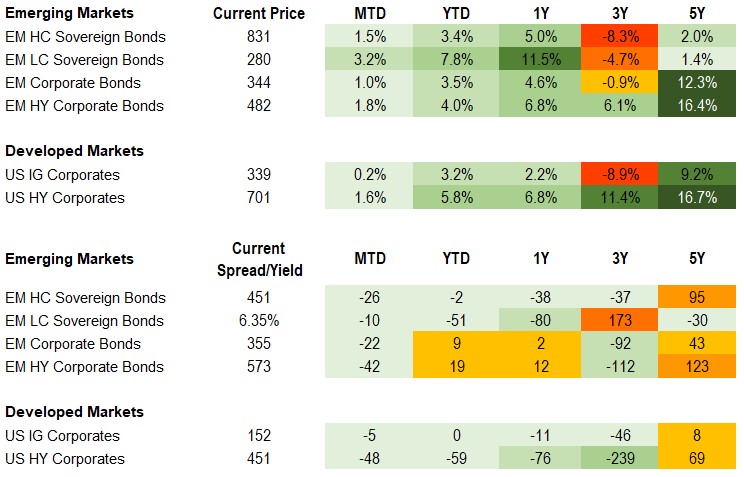
Equities
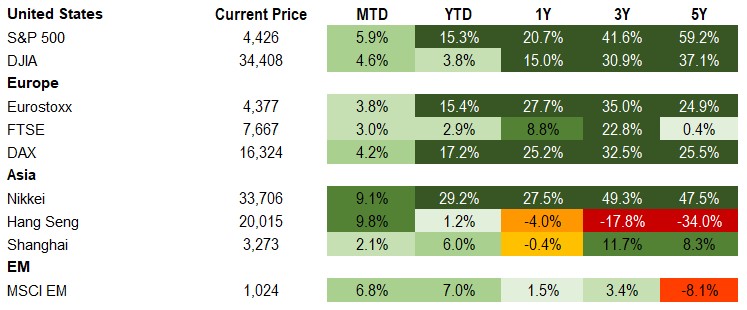
Commodities

Source for data tables: Bloomberg, JPMorgan, Gramercy. EM Fixed Income is represented by the following JPMorgan Indicies: EMBI Global, GBI-EM Global Diversified, CEMBI Broad Diversified and CEMBI Broad High Yield. DM Fixed Income is represented by the JPMorgan JULI Total Return Index and Domestic High Yield Index. Fixed Income, Equity and Commodity data is as of June 16, 2023 (mid-afternoon).
Emerging Markets Weekly Highlights
China rate cuts likely first step towards more stimulus
Event: The People’s Bank of China reduced its policy 7-day OMO rate by 10bps to 1.9% this week after a 9-month pause followed by a cut in the MLF rate by 10bps to 2.65%. This came on the heels of weaker than expected activity data as well as soft inflation data with May CPI at just 0.2% y/y and PPI at -4.6% y/y.
Gramercy commentary: Speculation of broader stimulus measures has grown recently and we see the move as a signal of the government’s desired policy direction in the coming weeks and months. With that being said, the direct support from the cuts is minimal. We expect the authorities to utilize monetary, property, and fiscal stimulus throughout the remainder of the year. It will still be balanced against the intent to continue to preserve financial stability and gradually reduce the role of the property sector in the economy over time. Measures should help domestic and EM asset prices in the near-term, although ultimately the easing is necessary to meet consensus growth targets for this year and thus, are unlikely to provide meaningful upside to existing expectations unless larger in size (~3-5 trillion RMB). Beyond near-term cyclical support, policy agenda meetings later this year could set out plans for a more holistic resolution for the distressed property market and local governments further supporting the evolution of the economy and medium-term growth.
Turkey at verge of economic management shift but market impact depends on nature and scope of forthcoming policy adjustment
Event: President Erdogan signaled this week that he would be willing to tolerate higher interest rates if his newly appointed economic team led by Mr. Mehmet Simsek, the Finance Minister, and Ms. Gaye Erkan, the Central Bank of the Republic of Turkey (CBRT) Governor, believe that would be a necessary step to stabilize the country’s macroeconomic situation.
Gramercy commentary: Following the two market-friendly appointments and President Erdogan showing willingness to give them autonomy over economic policy decisions in the early days of his new administration, Turkey-watchers have sharply recalibrated expectations on CBRT’s monetary policy outlook. The market now expects some initial normalization in CBRT’s extraordinarily low main interest rate at the next policy meeting on June 22nd. From our perspective, the key question is if the nature and scope of the likely policy adjustment would be bold enough to begin to restore market confidence in Turkey’s unbalanced macroeconomic environment. We think it is unlikely that the new economic team will risk its goodwill with Mr. Erdogan so soon into their tenure with an aggressive policy shift to full orthodoxy that in our estimate would necessitate an initial 3000+bps rate hike to the one-week repo rate of approximately 40% from 8.5% currently. Instead, a “hidden tightening approach” is likely to be used. Historical precedent shows that the CBRT has used an “interest rate corridor” that could allow it to achieve an “effective funding rate” that is higher than the official headline policy rate. In 2017-18, a gap of close to 500bps between the effective funding rate and the official policy rate developed. Depending on the level of nominal interest rates the new CBRT leadership will be comfortable with and the current staring conditions, the corridor might have to be significantly wider this time around. In this context, we believe inflows into local currency sovereign bonds by weary foreign investors would require a challenging set of conditions, including a material increase in local yields, further weakening of the currency and credible signaling on a near-term economic policy U-turn by Simsek and Erkan.
Markets welcome Nigeria’s reform flurry early into Tinubu Presidency
Event: Quick and decisive economic policy action by the new Tinubu Administration in Nigeria continued this week as the authorities allowed the national currency, the naira, to trade freely. As a result, the official naira rate devalued to ~650 against the USD, from ~450 previously and is expected to gradually converge with the long-standing “black market” rate of ~750 vs the dollar.
Gramercy commentary: Unification of Nigeria’s official and parallel exchange rate markets has been flagged as a key reform on the “wish list” of both investors and international partners such as the IMF for a long time. The Tinubu Administration has been able to deliver on FX reform as well as replace the Central Bank’s controversial governor less than one month into office. Moreover, these reforms come on the back of bold action last month in terms of abolishing long-standing inefficient fuel subsidies that were exerting a heavy toll on government finances. Despite the basic fuel type price tripling since the subsidy removal, social and political backlash has been limited, which signals that the reforms enjoy support by a broad spectrum of society. Overall, our impression from the early days of the Tinubu Administration is that the President has surrounded himself with a competent and proactive team that has taken bold action on key reforms which has been rewarded by market outperformance for Nigeria’s hard currency bonds. However, against a backdrop of still elevated fiscal challenges, especially in terms of local currency debt affordability, further tightening of the sovereign spreads would require continuation of the reform momentum to catalyze fresh capital inflows and ease investor concerns about fiscal risks.
Pakistan budget disappoints IMF
Event: The authorities presented their budget for the next 2023-24 fiscal year which entails a deficit of 6.5% of GDP, 50bps of consolidation relative to the prior year relying in large part on higher revenues from growth. Growth for 2024 is projected at 3.5% and inflation at 21%. Economic relief measures are ample for businesses and households while salaries and pensions for government employees are set to rise. The IMF responded to the contents of the budget critically, particularly on composition and nature of revenue proposals as well the tax amnesty component. Moody’s flagged similar concerns over the budget including overly optimistic funding assumptions which encompass market access and completion of the IMF program.
Gramercy commentary: The lackluster budget and strong pushback from the IMF suggests that chances for an agreement on the remaining disbursements before the official end of the program at month-end have declined. While a deal is still possible in the event of swift adjustments to the budget, Minister of Finance, Ishaq Dar’s comments suggest this is not necessarily the authorities’ plan. As such, we see the government continuing to rely on bilateral negotiations as well as import compression to muddle through until elections in 4Q, while still keeping dialogue with the IMF alive. In this backdrop, default risk remains elevated albeit Eurobond debt service for the remainder of the year is a modest $250 million. We ultimately think a moderate debt reprofiling leaves bond prices comfortably below likely recovery values despite near-term domestic political, external liquidity, and climate related risks.
Emerging Markets Technicals
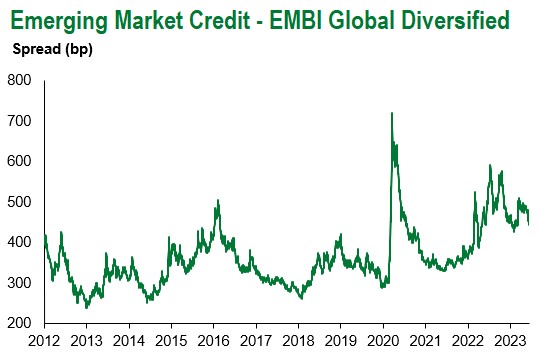
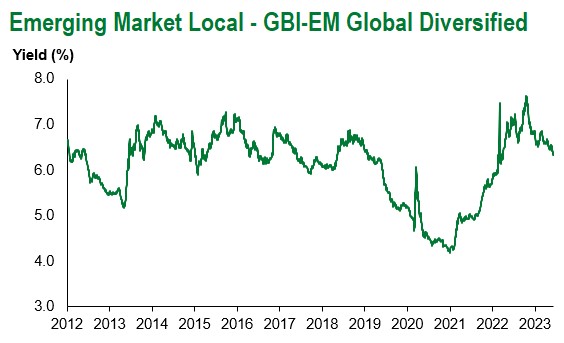
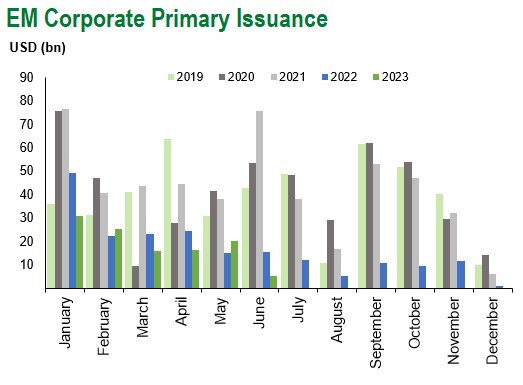
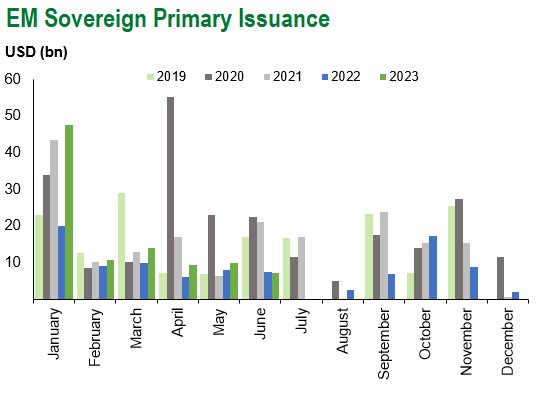
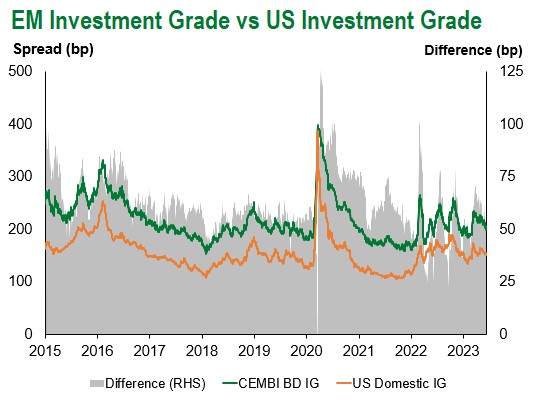
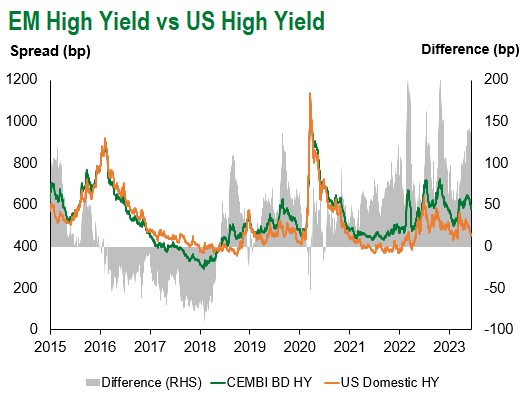
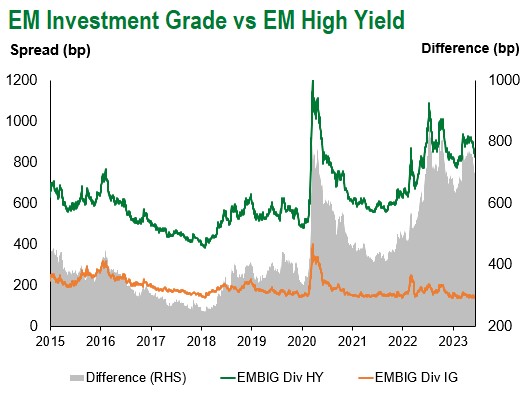
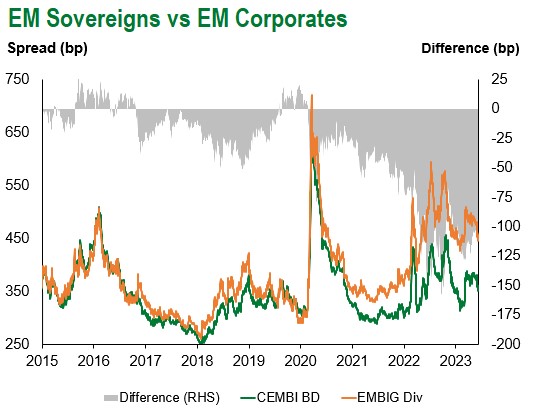
Emerging Markets Flows
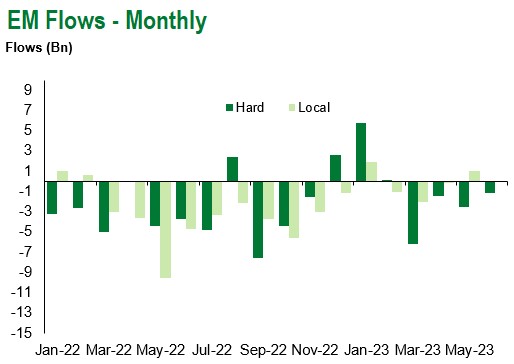
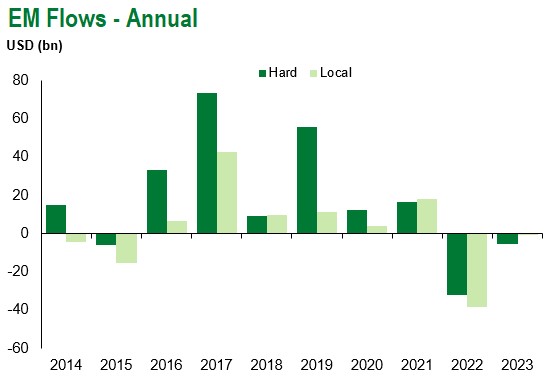
Source for graphs: Bloomberg, JPMorgan, Gramercy. As of June 16, 2023.
For questions, please contact:
Kathryn Exum, CFA ESG, Director, Co-Head of Sovereign Research, [email protected]
Petar Atanasov, Director, Co-Head of Sovereign Research, [email protected]
James Barry, Director, Deputy Portfolio Manager, [email protected]
This document is for informational purposes only. The information presented is not intended to be relied upon as a forecast, research or investment advice, and is not a recommendation, offer or solicitation to buy or sell any securities or to adopt any investment strategy. Gramercy may have current investment positions in the securities or sovereigns mentioned above. The information and opinions contained in this paper are as of the date of initial publication, derived from proprietary and nonproprietary sources deemed by Gramercy to be reliable, are not necessarily all-inclusive and are not guaranteed as to accuracy. This paper may contain “forward-looking” information that is not purely historical in nature. Such information may include, among other things, projections and forecasts. There is no guarantee that any forecasts made will come to pass. Reliance upon information in this paper is at the sole discretion of the reader. You should not rely on this presentation as the basis upon which to make an investment decision. Investment involves risk. There can be no assurance that investment objectives will be achieved. Investors must be prepared to bear the risk of a total loss of their investment. These risks are often heightened for investments in emerging/developing markets or smaller capital markets. International investing involves risks, including risks related to foreign currency, limited liquidity, less government regulation, and the possibility of substantial volatility due to adverse political, economic or other developments. References to any indices are for informational and general comparative purposes only. The performance data of various indices mentioned in this update are updated and released on a periodic basis before finalization. The performance data of various indices presented herein was current as of the date of the presentation. Please refer to data returns of the separate indices if you desire additional or updated information. Indices are unmanaged, and their performance results do not reflect the impact of fees, expenses, or taxes that may be incurred through an investment with Gramercy. Returns for indices assume dividend reinvestment. An investment cannot be made directly in an index. Accordingly, comparing results shown to those of such indices may be of limited use. The information provided herein is neither tax nor legal advice. Investors should speak to their tax professional for specific information regarding their tax situation.
